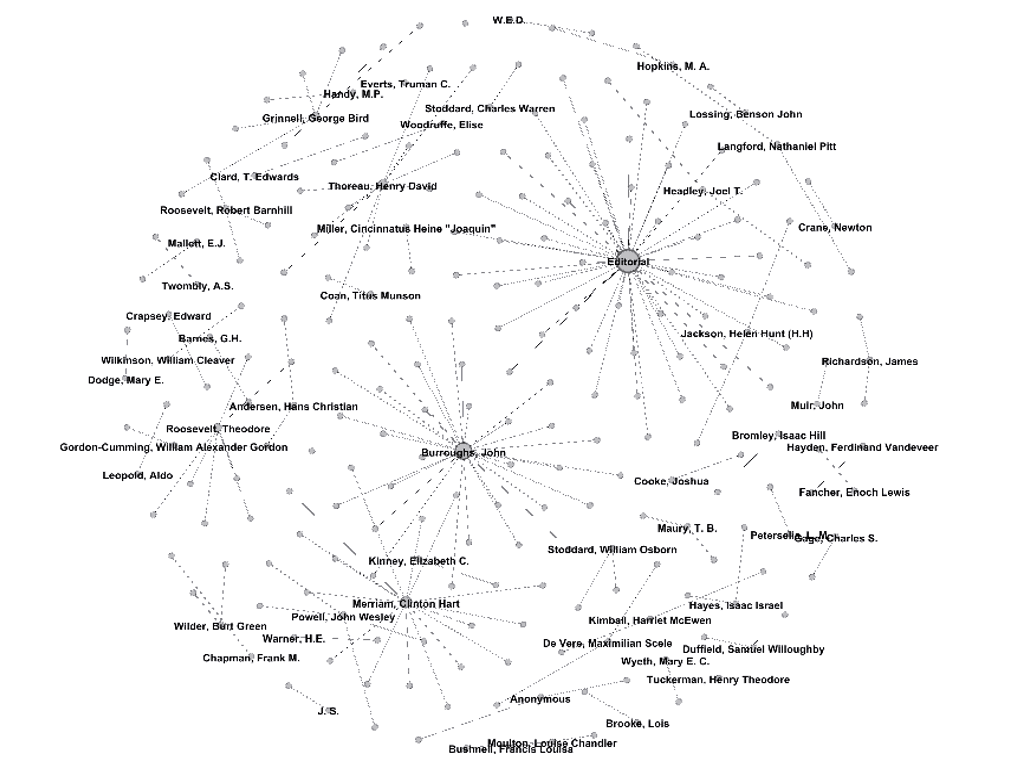My project is focused on exploring the development of environmental writing in American magazines during the nineteenth century. Many of the authors that we today think of as seminal environmental writers — authors such as John Muir, Sarah Orne Jewett, and John Burroughs — made a name for themselves by writing for magazines such as Scribner’s Monthly, The Atlantic Monthly, and The Century Magazine. These magazines played a major role building an audience for environmental writing in the United States and they helped to shape and were in turn shaped by their readers interest in environmental issues such as the creation of new national parks, the ecology of remote regions of the U.S., and even gardening tips.

In order to better understand the ways in which environmental writing developed within magazines during this period, I have been cataloging and categorizing articles about environmental topics from a variety of periodicals during the second half of the nineteenth century (my initial focus has been Scribner’s Monthly). As I read the magazine articles, I began to develop a taxonomy of environmental writing — a system that continues to change and evolve — which has allowed me to to identify some general trends in Scribner’s during this period, including a combined interest in gardening and botany, lots of articles about technology and geology, and a growing interest in the National Parks.
 Another emphasis of my project is to explore the collaborative nature of periodical publishing during this period. Though authors were certainly essential to getting environmental writing out there, they were a single part of the large number of people who got the final, bound periodical into the hands of readers. As this illustration of the Harper’s plant makes clear, publishing involved teams of people from typesetters to illustrators and engravers to editors who all had a hand in what the final product looked like on the printed page. While archival limitations mean that some of these contributions are lost to history, it’s essential to understand the ways in which these articles were the product of complex economic and intellectual networks that had a great influence how and when articles appeared. To help visualize these networks, I have also been working with network tools and Heurist, a database platform developed at the University of Sydney. This has allowed me to map out some of the connections and relationships that were so essential to the development of environmental writing in the United States during this period.
Another emphasis of my project is to explore the collaborative nature of periodical publishing during this period. Though authors were certainly essential to getting environmental writing out there, they were a single part of the large number of people who got the final, bound periodical into the hands of readers. As this illustration of the Harper’s plant makes clear, publishing involved teams of people from typesetters to illustrators and engravers to editors who all had a hand in what the final product looked like on the printed page. While archival limitations mean that some of these contributions are lost to history, it’s essential to understand the ways in which these articles were the product of complex economic and intellectual networks that had a great influence how and when articles appeared. To help visualize these networks, I have also been working with network tools and Heurist, a database platform developed at the University of Sydney. This has allowed me to map out some of the connections and relationships that were so essential to the development of environmental writing in the United States during this period.
As I continue with this project, my primary focus has been on continuing the data entry and on honing my database structure. I’ve also been working on learning JavaScript in order to present my visualizations using D3 visualizations. It’s a long process, but it’s been a rewarding one and I’m hoping that by my next blog post, I will have some initial visualizations to share!
Brady Krien
